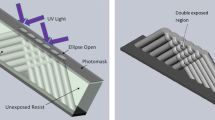Abstract
For the three-dimensional (3-D) numerical study of photoresist etching processes, the 2-D dynamic cellular automata (CA) model has been successfully extended to a 3-D dynamic CA model. Only the boundary cells will be processed in the 3-D dynamic CA model and the structure of “if-else” description in the simulation program is avoided to speed up the simulation. The 3-D dynamic CA model has found to be stable, fast and accurate for the numerical study of photoresist etching processes. The exposure simulation, post-exposure bake (PEB) simulation and etching simulation are integrated together to further investigate the performances of the CA model. Simulation results have been compared with the available experimental results and the simulations show good agreement with the available experiments.
Similar content being viewed by others
References
Strojwas A J, Zhu Z R, Ciplickas D, et al. Layout manufacturability analysis using rigorous 3-D topography simulation. In: Proceedings of IEEE Symposium on Semiconductor Manufacturing, San Jose, 2001. 263–266
Cole D C, Barouch E, Conrad E D, et al. Using advanced simulation to aid microlithography development. Proc IEEE, 2001, 89(8): 1194–1213
Hagouel P I, Neureuther A R. Modeling of X-ray resists for high-resolution lithography. In: Proceedings of ACS Organic Coatings and Plastics Chemistry, Chicago, 1975. 198–202
Dill F H, Neureuther A R, Tuttle J A, et al. Modeling projection printing of positive photoresists. IEEE Trans Electr Dev, 1975, 22(7): 456–464
Scheckler E W, Tam N N, Pfau A K, et al. An efficient volume-removal algorithm for practical three-dimensional lithography simulation with experimental verification. IEEE Trans Comput Aided Design Integr Circ Syst, 1993, 12(9): 1345–1356
Scheckler E W, Neureuther A R. Models and algorithms for three-dimensional topography simulation with SAMPLE-3D. IEEE Trans Comput Aided Design Integr Circ Syst, 1994, 13(2): 219–229
Kenny K H T, Neureuther A R, Scheckler E W. Algorithms for simulation of three-dimensional etching. IEEE Trans Comput Aided Design Integr Circ Syst, 1994, 13(5): 616–624
Karafyllidis I. A Three-dimensional photoresist etching simulator for TCAD. Modeling Simul Mater Sci Eng, 1999, 7(2): 157–167
Neumann V J. Theory of Self-reproducing Automata. Urbana: Uniersity of Illinois Press, 1966. 130–180
Wolfram S. Statistical mechanics of cellular automata. Rev Mod Phys, 1983, 55(3): 601–640
Wolfram S. Cellular automata as models of complexity. Nature, 1984, 311(4): 419–422
Karafyllidis I, Hagouel P I, Thanailakis A, et al. An efficient photoresist development simulator based on cellular automata with experimental verification. IEEE Trans Semicond Manuf, 2000, 13(1): 61–75
Zhu Z, Liu C. Simulation of anisotropic crystalline etching using a continuous cellular automata algorithm. J Comput Mod Eng Sci, 2000, 1(1): 11–20
Kansal A R, Torquato S. Simulated brain tumor growth dynamics using a three-dimentional cellular automata. J Theor Bio, 2000, 203: 367–382
Zhou Z F, Huang Q A, Li W H, et al. A two dimensional dynamic cellular automata model for simulation of photoresist etching process. In: Proceedings of ICSICT’2004, Beijing, 2004. 1076–1079
Ferguson R A. Modeling and simulation of reaction kinetics in advanced resist processes for optical lithography. Ph. D Thesis. California: University of California, Berkeley, 1991
Roberson S, Mack C A, Maslow M. Towards a universal resist dissolution model for lithography simulation. Proc SPIE, 2001, 4004: 111–122
Jakatdar N, Bao J W, Spanos C J, et al. A parameter extraction framework for DUV lithography simulation. Proc SPIE, 1999, 3677: 447–456
Jakatdar N, Niu X H, Spanos C J. Characterization of a chemically amplified photoresist for simulation using a modified “poor man’s DRM” methodology. Proc SPIE, 1998, 3332: 578–585
Erdmann A, Henke W, Robertson S, et al. Comparison of simulation approaches for chemically amplified resists. Proc SPIE, 2001, 4404: 99–110
Baluswamy P, Weatherly A, Kewley D, et al. Practical resist model calibration. Proc SPIE, 2003, 5040: 1556–1569
Author information
Authors and Affiliations
Corresponding author
Additional information
Supported by the National Outstanding Young Scientists Foundation of China (Grant No. 50325519)
Rights and permissions
About this article
Cite this article
Zhou, Z., Huang, Q., Li, W. et al. Numerical study on photoresist etching processes based on a cellular automata model. SCI CHINA SER E 50, 57–68 (2007). https://doi.org/10.1007/s11431-007-0005-5
Received:
Accepted:
Issue Date:
DOI: https://doi.org/10.1007/s11431-007-0005-5




